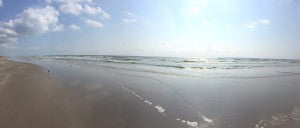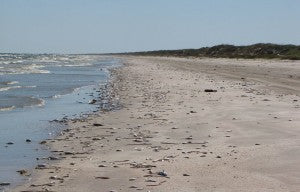Cleanup Update
By Tyler Thorsen

By Tyler Thorsen

By Tyler Thorsen
By Tyler Thorsen
By Tyler Thorsen



By Tyler Thorsen
By Tyler Thorsen
By Tyler Thorsen
Corpus Christi, TX -Reported conditions for Red Tide (Karenia brevis), a known harmful algal bloom (HAB), for Texas through Thursday, September 24 confirms dead fish and respiratory irritation from the Port Aransas/Mustang Island to Padre Island National Seashore regions. Water samples have confirmed background (less than 1 cell/ml) to high (> 1,000 cells/ml) concentrations of Red Tide along the coast of Texas from Galveston Bay to the Rio Grande (TPWD; 9/17-9/23). Samples collected along Padre Island have documented an increase in cell concentrations ranging from moderate to high, with the greatest densities observed at the Padre Island National Seashore from Mile marker 0 to mile marker 19. Winds forecasted today through Thursday have the potential to promote high levels of respiratory irritation in from Aransas Bay to the Rio Grande. Concentrations are patchy and discomfort to the eyes, nose, and throat will vary based upon local bloom concentrations, ocean currents, and wind speed and direction. Children, elderly, and individuals with asthma commonly experience elevated sensitivity and should avoid areas causing symptoms. Common symptoms include: coughing, sneezing, tearing, skin irritation, and difficulty breathing among others. Dogs are particularly sensitive to these conditions and may become sick or even require advance veterinary care if they ingest dead fish or lick any part of their body that comes into contact with beach sand or Gulf water.  If you plan on coming to the seashore please come prepared for the conditions. Bones and spines of dead fish can puncture feet and lead to serious infections. Driving conditions are also difficult; the number of fish on the beach makes this hazard hard to avoid and may leave you stranded with punctured vehicle tires. Caution is advised for persons with respiratory problems, infants, and pets being on the beach at this time. If you start to cough, have a burning sensation in your throat or itchy eye it is recommended that you leave the beach area.
If you plan on coming to the seashore please come prepared for the conditions. Bones and spines of dead fish can puncture feet and lead to serious infections. Driving conditions are also difficult; the number of fish on the beach makes this hazard hard to avoid and may leave you stranded with punctured vehicle tires. Caution is advised for persons with respiratory problems, infants, and pets being on the beach at this time. If you start to cough, have a burning sensation in your throat or itchy eye it is recommended that you leave the beach area.
For additional information: http://tidesandcurrents.noaa.gov/hab/ http://tidesandcurrents.noaa.gov/hab/beach_conditions.html https://tpwd.texas.gov/landwater/water/environconcerns/hab/redtide/status.phtml https://tpwd.texas.gov/landwater/water/environconcerns/hab/redtide/faq.phtml
By Tyler Thorsen
 Pet owners are strongly cautioned against bringing their pet(s) onto the beach during a red tide event. Here at Padre Island National Seashore we strive to let the public know that this is a dog friendly park. However there are some times when it is not good for your pet to be on the beach. A red tide event, like the one we are experiencing right now, is not a good time for your dog to be near the shore. Below you will find some important information concerning red tide (which creates Brevetoxin) and the well being of your pet: • Brevetoxin poisoning may occur from eating or licking dead/decaying fish or other items on the beach, or by exposure to water, foam, or sand/sediment. • Clinical signs of toxin exposure can occur after very limited time on the beach (20 minutes in one case). Please keep your dog on a leash at all times. • Do not let your dog dig into the sand or pick up/lick any item from the beach, including sticks, shells, carcasses, or trash. • Do not allow your dog to drink from the surf or from pools of water on the beach. • A basket muzzle may keep your dog from picking up items from the beach, however most basket muzzles are designed to allow a dog to drink or lick, which could lead to exposure. Other muzzle types are not recommended. • If you suspect that your dog has picked up or licked any item on the beach, rinse its mouth with copious amounts of fresh water. • If you believe that your dog has swallowed or licked an item, rinse its mouth as above, keep it off the beach, and watch closely for the following signs (which usually start within 12-24 hours, sometime much sooner): -Excessive drooling -Vomiting -Lethargy or reluctance to move -Decreased appetite -Weakness in any limb or an inability to hold the head up normally -Head or body tremors, seizures, or other abnormal neurological -signs -Respiratory difficulty -Any other behaviors or physical signs that you feel are abnormal for your dog • If any of those signs appear, or if you are at all concerned, please contact a veterinarian immediately. Keep in mind that dogs showing the above signs may be ill from causes other than Brevetoxin exposure, and some of those causes can be equally serious. • There is no specific “antidote” for Brevetoxin poisoning, and there is no rapid test to detect the toxin, so veterinary care is generally supportive and may include: -Induction of vomiting (if appropriate; if certain sharp items are ingested, vomiting is NOT recommended) -Administration of a gastrointestinal toxin-binding agent -Hospitalization with intravenous fluid therapy -Intravenous or oral gastrointestinal protection medication -Anti-seizure medication and/or sedation -Testing for other causes of illness Each case is unique, and only a veterinarian can determine the appropriate course of testing and treatment for each patient. Veterinary therapy does not guarantee a successful outcome, however in most cases it greatly increases the chances of survival.
Pet owners are strongly cautioned against bringing their pet(s) onto the beach during a red tide event. Here at Padre Island National Seashore we strive to let the public know that this is a dog friendly park. However there are some times when it is not good for your pet to be on the beach. A red tide event, like the one we are experiencing right now, is not a good time for your dog to be near the shore. Below you will find some important information concerning red tide (which creates Brevetoxin) and the well being of your pet: • Brevetoxin poisoning may occur from eating or licking dead/decaying fish or other items on the beach, or by exposure to water, foam, or sand/sediment. • Clinical signs of toxin exposure can occur after very limited time on the beach (20 minutes in one case). Please keep your dog on a leash at all times. • Do not let your dog dig into the sand or pick up/lick any item from the beach, including sticks, shells, carcasses, or trash. • Do not allow your dog to drink from the surf or from pools of water on the beach. • A basket muzzle may keep your dog from picking up items from the beach, however most basket muzzles are designed to allow a dog to drink or lick, which could lead to exposure. Other muzzle types are not recommended. • If you suspect that your dog has picked up or licked any item on the beach, rinse its mouth with copious amounts of fresh water. • If you believe that your dog has swallowed or licked an item, rinse its mouth as above, keep it off the beach, and watch closely for the following signs (which usually start within 12-24 hours, sometime much sooner): -Excessive drooling -Vomiting -Lethargy or reluctance to move -Decreased appetite -Weakness in any limb or an inability to hold the head up normally -Head or body tremors, seizures, or other abnormal neurological -signs -Respiratory difficulty -Any other behaviors or physical signs that you feel are abnormal for your dog • If any of those signs appear, or if you are at all concerned, please contact a veterinarian immediately. Keep in mind that dogs showing the above signs may be ill from causes other than Brevetoxin exposure, and some of those causes can be equally serious. • There is no specific “antidote” for Brevetoxin poisoning, and there is no rapid test to detect the toxin, so veterinary care is generally supportive and may include: -Induction of vomiting (if appropriate; if certain sharp items are ingested, vomiting is NOT recommended) -Administration of a gastrointestinal toxin-binding agent -Hospitalization with intravenous fluid therapy -Intravenous or oral gastrointestinal protection medication -Anti-seizure medication and/or sedation -Testing for other causes of illness Each case is unique, and only a veterinarian can determine the appropriate course of testing and treatment for each patient. Veterinary therapy does not guarantee a successful outcome, however in most cases it greatly increases the chances of survival.